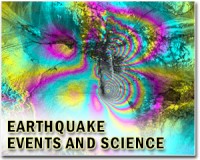| . |  |
. |
West Lafayette IN (SPX) Aug 03, 2010 A new theory developed at Purdue University may solve the mystery of why the New Madrid fault, which lies in the middle of the continent and not along a tectonic plate boundary, produces large earthquakes such as the ones that shook the eastern United States in 1811 and 1812. The theory suggests that the energy necessary to produce the magnitude 7-7.5 earthquakes came from stored stress built up in the Earth's crust long ago. Rapid erosion from the Mississippi River at the end of the last ice age reduced forces that had kept the New Madrid fault from slipping and triggered the temblors. Eric Calais, the Purdue professor of earth and atmospheric sciences who led the study, said the theory is the first to explain how a fault could have had large earthquakes in the recent past but today show no signs of accumulating the forces needed to produce another earthquake. "We understand why earthquakes happen at the contact between tectonic plates, like in California, but it has always been a puzzle as to why earthquakes occur in the middle of the continent as well, and with no visible surface deformation," Calais said. "Our theory links an external climate-driven process, the melting of the ice sheet, and earthquakes." Calais and others have analyzed the fault for more than 10 years using global position system measurements to capture movements of the Earth's surface that represent a buildup of energy and have traditionally been used to evaluate the potential for an earthquake. As the data was collected, it became evident that such motion was not occurring along the New Madrid fault. Andrew Freed, co-author of the paper and an associate professor of earth and atmospheric sciences at Purdue, said with no discernable motions at the surface to explain how the requisite crustal stresses could have built up in this area, these stresses must be left over from past tectonic processes that are no longer active. "The only way to reconcile the fact that this part of the continent is not deforming but is producing earthquakes is for the stresses to have built up long ago, " Freed said. "Old geologic processes, such as the opening of the Atlantic and the uplift of the Rocky Mountains, may have squeezed the Midwest. The resulting stress remained stored for millions of years until uplift associated with the Mississippi erosion event led to the unclamping of old faults lying beneath." If this area of the North American continent is preloaded with the stress that can lead to earthquakes, it will be difficult to assess earthquake risk in the region. The fault segments that ruptured are unlikely to have future earthquakes as there is no current means to reload them, but there remains a risk that other faults in the region could experience large earthquakes in the future, Calais said. "Unfortunately, this stored stress is invisible to us, and the usual methods of measuring strain and deformation to evaluate a spot's potential for an earthquake may not apply to this region," Calais said. "Under these conditions, once an earthquake occurs on a given fault, it's done; but this also means that other faults in the region that appear quiet today may still be triggered." Details of the team's work, which was supported by a grant from the U.S. Geological Survey, appear in a paper in the current issue of Nature. For a period from 16,000 to 10,000 years ago as the ice sheet melted, it steadily rushed water down the Mississippi River. As the river flowed, it washed away sediments and removed weight pressing down on the Earth's crust. With this relatively rapid removal of weight, the crust rebounded and bulged slightly up from its previous position. This slight arching caused the top layers of the Earth's crust to be stretched and the bottom layers to be compacted, exerting forces on the preexisting faults sufficient to trigger the earthquakes that began more than 3,000 years ago in the New Madrid region, culminating with the 1811-1812 events, Calais said. More data needs to be collected to see whether this mechanism applies to similar seismic zones in the world, he said. Additional paper co-authors include Roy Van Arsdale of the University of Memphis and Seth Stein of Northwestern University.
Share This Article With Planet Earth
Related Links Purdue University Bringing Order To A World Of Disasters When the Earth Quakes A world of storm and tempest
 One dead, dozens injured in southern Iran quake: reports
One dead, dozens injured in southern Iran quake: reportsTehran (AFP) July 21, 2010 A 5.8 magnitude earthquake shook southern Iran early Wednesday, killing one person, injuring dozens and damaging houses in four villages near the town of Lamerd, media reports said. State television's website reported that "an 80-year-old woman, who was injured in the earthquake, died of internal bleeding after she was taken to hospital in Lamerd." The tremor just after midnight was foll ... read more |
|
| The content herein, unless otherwise known to be public domain, are Copyright 1995-2010 - SpaceDaily. AFP and UPI Wire Stories are copyright Agence France-Presse and United Press International. ESA Portal Reports are copyright European Space Agency. All NASA sourced material is public domain. Additional copyrights may apply in whole or part to other bona fide parties. Advertising does not imply endorsement,agreement or approval of any opinions, statements or information provided by SpaceDaily on any Web page published or hosted by SpaceDaily. Privacy Statement |